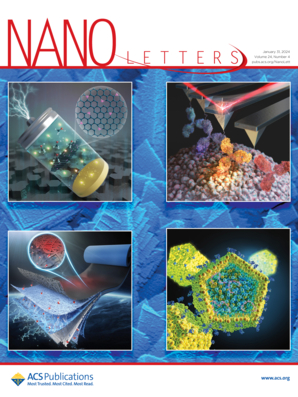Biomimetic Metal-Organic Antioxidant Eye Drops for Corneal Neovascularization: Visible-Light-Triggered CO Release for Microenvironment Regulation.
IF 9.6
1区 材料科学
Q1 CHEMISTRY, MULTIDISCIPLINARY
引用次数: 0
Abstract
As the primary photosensitive region, the ocular surface is susceptible to significant oxidative stress and inflammation. The development and progression of corneal neovascularization (CNV) are closely associated with these conditions. By utilizing the photosensitive properties of the cornea, we present novel biomimetic antioxidant eye drops capable of releasing carbon monoxide (CO) gas signaling molecules under visible light. Using Mn-TCPP, Bpy-COOH, Zr(IV) chloride octahydrate, and Mn(CO)5Br co-assembly and then coating with anti-VEGFR2 single-chain antibody genetically engineered cell membrane vesicles (ScFv) successfully synthesize the nanomedicine ZrMn/CO@ScFv. Administered through eye drops, the nanomedicine effectively inhibits oxidative stress and reduces local edema and inflammation. Meanwhile, it can inhibit the expression of angiogenic factors CD31 and VEGF and effectively treat neovascularization. The synergy of antioxidant and gas therapy is confirmed as a safe and productive strategy for CNV management.用于角膜新生血管的仿生金属有机抗氧化滴眼液:微环境调节的可见光触发CO释放。
眼表作为主要的光敏区,易受氧化应激和炎症的影响。角膜新生血管(CNV)的发生和发展与这些条件密切相关。利用角膜的光敏特性,我们提出了一种新型仿生抗氧化滴眼液,能够在可见光下释放一氧化碳(CO)气体信号分子。利用Mn- tcpp、Bpy-COOH、Zr(IV)氯八水合物和Mn(CO)5Br共组装,然后包被抗vegfr2单链抗体的基因工程细胞膜囊泡(ScFv)成功合成纳米药物ZrMn/CO@ScFv。通过滴眼液给药,这种纳米药物能有效抑制氧化应激,减少局部水肿和炎症。同时能抑制血管生成因子CD31和VEGF的表达,有效治疗新生血管。抗氧化剂和气体治疗的协同作用被证实是一种安全有效的CNV管理策略。
本文章由计算机程序翻译,如有差异,请以英文原文为准。
求助全文
约1分钟内获得全文
求助全文
来源期刊

Nano Letters
工程技术-材料科学:综合
CiteScore
16.80
自引率
2.80%
发文量
1182
审稿时长
1.4 months
期刊介绍:
Nano Letters serves as a dynamic platform for promptly disseminating original results in fundamental, applied, and emerging research across all facets of nanoscience and nanotechnology. A pivotal criterion for inclusion within Nano Letters is the convergence of at least two different areas or disciplines, ensuring a rich interdisciplinary scope. The journal is dedicated to fostering exploration in diverse areas, including:
- Experimental and theoretical findings on physical, chemical, and biological phenomena at the nanoscale
- Synthesis, characterization, and processing of organic, inorganic, polymer, and hybrid nanomaterials through physical, chemical, and biological methodologies
- Modeling and simulation of synthetic, assembly, and interaction processes
- Realization of integrated nanostructures and nano-engineered devices exhibiting advanced performance
- Applications of nanoscale materials in living and environmental systems
Nano Letters is committed to advancing and showcasing groundbreaking research that intersects various domains, fostering innovation and collaboration in the ever-evolving field of nanoscience and nanotechnology.
 求助内容:
求助内容: 应助结果提醒方式:
应助结果提醒方式:


